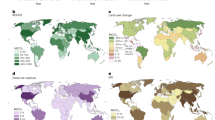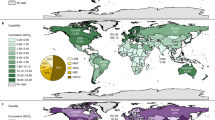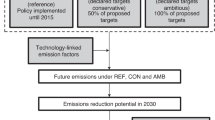Abstract
Carbon dioxide removal (CDR) technologies may be needed to meet climate change targets. A full understanding of public attitudes towards such approaches is currently lacking. Here we report a mixed-methods study on public perceptions of CDR in the United States and the United Kingdom, focusing on bioenergy with carbon capture and storage, direct air capture and terrestrial enhanced rock weathering. A discourse of climate urgency had a substantial impact on perceptions, with CDR seen as offering too slow a response to the climate crisis. CDR also fails to reflect long-term hopes for a sustainable world, being interpreted as not addressing the root causes of climate change. A social license to operate may therefore depend on resolving these temporal dilemmas regarding both the short- and long-term implications of technology development. While research under well-controlled conditions is likely to be acceptable, at-scale deployment without corresponding efforts to reduce emissions may represent a red line for many people.
This is a preview of subscription content, access via your institution
Access options
Access Nature and 54 other Nature Portfolio journals
Get Nature+, our best-value online-access subscription
$29.99 / 30 days
cancel any time
Subscribe to this journal
Receive 12 print issues and online access
$209.00 per year
only $17.42 per issue
Buy this article
- Purchase on Springer Link
- Instant access to full article PDF
Prices may be subject to local taxes which are calculated during checkout



Similar content being viewed by others
Data availability
The survey data have been made publicly available in Cardiff University Open Data Repository: https://doi.org/10.17035/d.2020.0101974649 (survey data)63 and https://doi.org/10.17035/d.2020.0106264948 (questionnaire data)64. The workshop audio files and transcripts cannot be made publicly available due to the need to respect participant confidentiality. However, we will consider requests to share the anonymized transcripts (for research purposes only) on a case-by-case basis after an embargo of two years, during which time our analysis continues. Any other data are available from the corresponding author on reasonable request. Source data are provided with this paper.
References
Adoption of the Paris Agreement FCCC/CP/2015/L.9/Rev.1 (UNFCCC, 2015).
Greenhouse Gas Removal (Royal Society and Royal Academy of Engineering, 2018).
Friedmann, S. J. Engineered CO2 removal, climate restoration, and humility. Front. Clim. 1, 3 (2019).
Minx, J. C. et al. Negative emissions—part 1: research landscape and synthesis. Environ. Res. Lett. 13, 063001 (2018).
Bradshaw, M. & Waite, C. Learning from Lancashire: exploring the contours of the shale gas conflict in England. Glob. Environ. Change 47, 28–36 (2017).
Grove-White, R., Macnaghten, P. & Wynne, B. Wising Up: The Public and New Technologies (Centre for the Study of Environmental Change, Lancaster University and Unilever, 2000).
Terwel, B. W., ter Mors, E. & Daamen, D. D. L. It’s not only about safety: beliefs and attitudes of 811 local residents regarding a CCS project in Barendrecht. Int. J. Greenh. Gas Control 9, 41–51 (2012).
Fiorino, D. J. Citizen participation and environmental risk: a survey of institutional mechanisms. Sci. Technol. Hum. Values 15, 226–243 (1990).
Moffat, K., Lacey, J., Zhang, A. & Leipold, S. The social licence to operate: a critical review. Forestry 89, 477–488 (2016).
Nemet, G. F. et al. Negative emissions—part 3: innovation and upscaling. Environ. Res. Lett. 13, 063003 (2018).
Bellamy, R., Chilvers, J. & Vaughan, N. E. Deliberative mapping of options for tackling climate change: citizens and specialists ‘open up’ appraisal of geoengineering. Public Underst. Sci. 25, 269–286 (2016).
Wibeck, V. et al. Making sense of climate engineering: a focus group study of lay publics in four countries. Climatic Change 145, 1–14 (2017).
McLaren, D., Parkhill, K. A., Corner, A., Vaughan, N. E. & Pidgeon, N. F. Public conceptions of justice in climate engineering: evidence from secondary analysis of public deliberation. Glob. Environ. Change 41, 64–73 (2016).
Cox, E. M., Pidgeon, N., Spence, E. & Thomas, G. Blurred lines: the ethics and policy of greenhouse gas removal at scale. Front. Environ. Sci. 6, 38 (2018).
Corner, A., Parkhill, K., Pidgeon, N. & Vaughan, N. E. Messing with nature? Exploring public perceptions of geoengineering in the UK. Glob. Environ. Change 23, 938–947 (2013).
Wolske, K. S., Raimi, K. T., Campbell-Arvai, V. & Hart, P. S. Public support for carbon dioxide removal strategies: the role of tampering with nature perceptions. Climatic Change 152, 345–361 (2019).
Demski, C., Butler, C., Parkhill, K. A., Spence, A. & Pidgeon, N. F. Public values for energy system change. Glob. Environ. Change 34, 59–69 (2015).
Butler, C., Parkhill, K. & Pidgeon, N. F. Deliberating Energy System Transitions in the UK (UK Energy Research Centre, 2013).
Mabon, L. & Shackley, S. Meeting the targets or re-imagining society? An empirical study into the ethical landscape of carbon dioxide capture and storage in Scotland. Environ. Values 24, 465–482 (2015).
Thomas, G., Pidgeon, N. & Roberts, E. Ambivalence, naturalness and normality in public perceptions of carbon capture and storage in biomass, fossil energy, and industrial applications in the United Kingdom. Energy Res. Soc. Sci. 46, 1–9 (2018).
Cox, E., Spence, E. & Pidgeon, N. Incumbency, trust and the Monsanto effect: stakeholder discourses on greenhouse gas removal. Environ. Values 29, 197–220 (2020).
Slovic, P. The Feeling of Risk: New Perspectives on Risk Perception (Routledge, 2010).
Pidgeon, N. F., Hood, C., Jones, D., Turner, B. & Gibson, R. in Risk—Analysis, Perception and Management: Report of a Royal Society Study Group 89–134 (Royal Society, 1992).
Pidgeon, N. F. & Spence, E. Perceptions of enhanced weathering as a biological negative emissions option. Biol. Lett. 13, 20170024 (2017).
Daamen, D., de Best-Waldhober, M., Damen, K. & Faaij, A. Pseudo-opinions on CCS technologies. In GHGT-8 (2006).
Fischhoff, B. & Fischhoff, I. Publics’ opinions about biotechnologies. AgBioForum 4, 155–162 (2002).
Jones, C. R., Radford, R. L., Armstrong, K. & Styring, P. What a waste! Assessing public perceptions of carbon dioxide utilisation technology. J. CO2 Util. 7, 51–54 (2014).
National Academies of Sciences, Engineering and Medicine Negative Emissions Technologies and Reliable Sequestration: A Research Agenda (National Academies Press, 2019).
Markusson, N., McLaren, D. & Tyfield, D. Towards a cultural political economy of mitigation deterrence by negative emissions technologies (NETs). Glob. Sustain. 1, e10 (2018).
Bickerstaff, K., Simmons, P. & Pidgeon, N. Public Perceptions of Risk, Science and Governance: Main Findings of a Qualitative Study of Six Risk Cases (2006).
Fowlkes, M. R. & Miller, P. Y. in The Social and Cultural Construction of Risk: Essays on Risk Selection and Perception (eds Johnson, B. B. & Covello, V. T.) 55–78 (Springer, 1987).
National Academy of Sciences. Climate Intervention: Carbon Dioxide Removal and Reliable Sequestration (National Academies Press, 2015).
Macnaghten, P., Davies, S. R. & Kearnes, M. Understanding public responses to emerging technologies: a narrative approach. J. Environ. Policy Plan. 21, 504–518 (2015).
Leiserowitz, A. Climate change risk perception and policy preferences: the role of affect, imagery, and values. Climatic Change 77, 45–72 (2006).
Upham, P. & Roberts, T. Public perceptions of CCS in context: results of NearCO2 focus groups in the UK, Belgium, the Netherlands, Germany, Spain and Poland. Energy Procedia 4, 6338–6344 (2011).
Lotze, H. K., Guest, H., O’Leary, J., Tuda, A. & Wallace, D. Public perceptions of marine threats and protection from around the world. Ocean Coast. Manag. 152, 14–22 (2018).
Bellamy, R., Lezaun, J. & Palmer, J. Perceptions of bioenergy with carbon capture and storage in different policy scenarios. Nat. Commun. 10, 743 (2019).
L’Orange Seigo, S., Dohle, S. & Siegrist, M. Public perception of carbon capture and storage (CCS): a review. Renew. Sustain. Energy Rev. 38, 848–863 (2014).
Dowd, A.-M., Itaoka, K., Ashworth, P., Saito, A. & de Best-Waldhober, M. Investigating the link between knowledge and perception of CO2 and CCS: an international study. Int. J. Greenh. Gas Control 28, 79–87 (2014).
Realmonte, G. et al. An inter-model assessment of the role of direct air capture in deep mitigation pathways. Nat. Commun. 10, 3277 (2019).
Lefebvre, D. et al. Assessing the potential of soil carbonation and enhanced weathering through life cycle assessment: a case study for Sao Paulo State, Brazil. J. Clean. Prod. 233, 468–481 (2019).
Spence, E., Pidgeon, N. & Pearson, P. UK public perceptions of ocean acidification—the importance of place and environmental identity. Mar. Policy 97, 287–293 (2018).
Gore, S., Renforth, P. & Perkins, R. The potential environmental response to increasing ocean alkalinity for negative emissions. Mitig. Adapt. Strateg. Glob. Change 24, 1191–1211 (2018).
Owen, R., Bessant, J. R. & Heintz, M. Responsible Innovation: Managing the Responsible Emergence of Science and Innovation in Society (John Wiley, 2013).
Macnaghten, P. Researching technoscientific concerns in the making: narrative structures, public responses, and emerging nanotechnologies. Environ. Plan. Econ. Space 42, 23–37 (2010).
Marris, C. Public views on GMOs: deconstructing the myths. EMBO Rep. 2, 545–548 (2001).
Pidgeon, N. & Fischhoff, B. The role of social and decision sciences in communicating uncertain climate risks. Nat. Clim. Change 1, 35–41 (2011).
Carr, W. A. & Yung, L. Perceptions of climate engineering in the South Pacific, Sub-Saharan Africa, and North American Arctic. Climatic Change 147, 119–132 (2018).
Bellamy, R., Chilvers, J., Vaughan, N. E. & Lenton, T. M. ‘Opening up’ geoengineering appraisal: multi-criteria mapping of options for tackling climate change. Glob. Environ. Change 23, 926–937 (2013).
Anderson, K. & Peters, G. The trouble with negative emissions. Science 354, 182–183 (2016).
Macnaghten, P. & Szerszynski, B. Living the global social experiment: an analysis of public discourse on solar radiation management and its implications for governance. Glob. Environ. Change 23, 465–474 (2013).
Pidgeon, N., Demski, C., Butler, C., Parkhill, K. & Spence, A. Creating a national citizen engagement process for energy policy. Proc. Natl Acad. Sci. USA 111, 13606–13613 (2014).
Degeling, C., Carter, S. M. & Rychetnik, L. Which public and why deliberate? A scoping review of public deliberation in public health and health policy research. Soc. Sci. Med. 131, 114–121 (2015).
Cox, E. & Edwards, N. R. Beyond carbon pricing: policy levers for negative emissions technologies. Clim. Policy 19, 1144–1156 (2019).
Corner, A., Parkhill, K. A. & Pidgeon, N. ‘Experiment Earth?’ Reflections on a Public Dialogue on Geoengineering (Cardiff University, 2011).
Braun, V. & Clarke, V. Using thematic analysis in psychology. Qual. Res. Psychol. 3, 77–101 (2006).
Macnaghten, P. in A New Era in Focus Group Research (eds Barbour, R. & Morgan, D. L.) 343–363 (Palgrave Macmillan, 2017).
Macnaghten, P. & Myers, G. in Qualitative Research Practice (eds Seale, C., Giampietro Gobo, J. G. & Silverman, D.) 65–79 (Sage, 2004).
Steentjes, K. et al. European Perceptions of Climate Change (EPCC): Topline Findings of a Survey Conducted in Four European Countries in 2016 (EPCC, 2017).
Pidgeon, N. F. et al. Using surveys in public participation processes for risk decision making: the case of the 2003 British GM nation? Public debate. Risk Anal. 25, 467–479 (2005).
Merk, C., Pönitzsch, G., Kniebes, C., Rehdanz, K. & Schmidt, U. Exploring public perceptions of stratospheric sulfate injection. Climatic Change 130, 299–312 (2015).
Fuss, S. et al. Research priorities for negative emissions. Environ. Res. Lett. 11, 115007 (2016).
Spence, E. & Cox, E. Survey data for US and UK on public risk perceptions of carbon dioxide removal (CDR). Cardiff University Open Data Repository https://doi.org/10.17035/d.2020.0101974649 (2020).
Cox, E. & Spence, E. Carbon dioxide removal questionnaire results. Cardiff University Open Data Repository https://doi.org/10.17035/d.2020.0106264948 (2020).
Acknowledgements
This research was funded by the Leverhulme Trust under project research grant RC-2015-029. We are indebted to members of the LC3M advisory board for their design input and ongoing support, and to the University of Illinois Extension Office and Evan de Lucia lab for fieldwork assistance. We also thank V. Campbell-Arvai, P. Ashworth, M. Ferguson, T. Kruger, N. Vaughan, G. Henderson, D. Evensen and A. Flewker for help with survey design and workshop materials.
Author information
Authors and Affiliations
Contributions
E.C., E.S. and N.P. were involved in the conceptualization of the research. E.C. designed and facilitated the workshops and analysed the qualitative and questionnaire data. E.S. designed the survey and analysed the survey data. E.C. wrote the original draft. E.C., E.S. and N.P. were involved in writing, review and editing of the manuscript. N.P. acquired funding.
Corresponding authors
Ethics declarations
Competing interests
The authors declare no competing interests.
Additional information
Publisher’s note Springer Nature remains neutral with regard to jurisdictional claims in published maps and institutional affiliations.
Supplementary information
Supplementary Information
Supplementary Methods 1–6 and Tables 1–3.
Source data
Source Data Fig. 1
Source data for Fig. 1: risk and benefit perceptions survey questions. Excel file, 92 kB.
Source Data Fig. 3
Source data for Fig. 3: root cause survey question. Excel file, 48 kB.
Source Data Table 1
Source data for Table 1: workshop questionnaire responses. Excel file, 17 kB.
Rights and permissions
About this article
Cite this article
Cox, E., Spence, E. & Pidgeon, N. Public perceptions of carbon dioxide removal in the United States and the United Kingdom. Nat. Clim. Chang. 10, 744–749 (2020). https://doi.org/10.1038/s41558-020-0823-z
Received:
Accepted:
Published:
Issue Date:
DOI: https://doi.org/10.1038/s41558-020-0823-z
This article is cited by
-
Public perceptions and support of climate intervention technologies across the Global North and Global South
Nature Communications (2024)
-
Communities conditionally support deployment of direct air capture for carbon dioxide removal in the United States
Communications Earth & Environment (2024)
-
A taxonomy to map evidence on the co-benefits, challenges, and limits of carbon dioxide removal
Communications Earth & Environment (2024)
-
German citizens’ preference for domestic carbon dioxide removal by afforestation is incompatible with national removal potential
Communications Earth & Environment (2023)
-
How climate policy commitments influence energy systems and the economies of US states
Nature Communications (2023)



